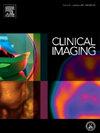韩国肺癌筛查CT项目中冠状动脉钙化的人工智能辅助纵向评估
IF 1.5
4区 医学
Q3 RADIOLOGY, NUCLEAR MEDICINE & MEDICAL IMAGING
引用次数: 0
摘要
目的冠状动脉钙化(CAC)生长的临床意义尚不清楚。本研究旨在利用人工智能(AI)辅助评估进行肺癌筛查(LCS)的个体中CAC的生长及其与不良心血管事件(ace)的关系。方法纳入2017年4月至2023年12月期间接受LCS低剂量胸部CT (LDCT)检查的患者,并进行随访LDCT扫描。采用基于人工智能的软件对CAC严重程度进行量化。CAC增长被定义为基线CAC = 0或年进展>的CAC事件;基线CAC >患者的15%;0. ace分为重大事件和次要事件。使用Cox回归模型评估CAC生长与ace之间的关系,调整基线年龄和CAC状态。结果男性患者193例;平均年龄(61.6±5.2岁)。在4年的平均随访中,15.5%经历过ace(主要事件:4.1%,次要事件:11.4%)。基线CAC严重程度越高,CAC年增幅越高(p <;0.001)。年龄(校正风险比(HR)(95%可信区间(CI)) = 1.08 (1.00, 1.17);p = 0.041), CAC增长(调整人力资源(95% CI) = 2.40 (1.13, 5.09);p = 0.023),中度至重度基线CAC(调整后HR (95% CI) = 2.86 (1.11, 7.38);p = 0.030)与总ace发生率显著相关。结论sai辅助的连续LDCT扫描CAC生长跟踪在LCS人群中具有预后价值,可以指导临床实践中基于风险的心血管随访和预防策略。本文章由计算机程序翻译,如有差异,请以英文原文为准。
Artificial intelligence-assisted longitudinal assessment of coronary artery calcification in the Korean lung cancer screening CT program
Purpose
The clinical implications of coronary artery calcification (CAC) growth remain underexplored. This study aims to assess CAC growth and its association with adverse cardiovascular events (ACEs) in individuals undergoing lung cancer screening (LCS) using artificial intelligence (AI)-assisted evaluation.
Methods
We included patients who underwent LCS low-dose chest CT (LDCT) between April 2017 and December 2023 with available follow-up LDCT scans. CAC severity was quantified using AI-based software. CAC growth was defined as incident CAC in those with baseline CAC = 0 or annual progression > 15 % in those with baseline CAC > 0. ACEs were categorized as major or minor events. Associations between CAC growth and ACEs were evaluated using Cox regression models, adjusting for baseline age and CAC status.
Results
Male patients (n = 193; mean age, 61.6 ± 5.2 years) were analyzed. Over a 4-year mean follow-up, 15.5 % experienced ACEs (major event: 4.1 %, minor event: 11.4 %). Greater baseline CAC severity correlated with a higher annual CAC increase (p < 0.001). Age (adjusted hazard ratio (HR) (95 % confidence interval (CI)) = 1.08 (1.00, 1.17); p = 0.041), CAC growth (adjusted HR (95 % CI) = 2.40 (1.13, 5.09); p = 0.023), and moderate to severe baseline CAC (adjusted HR (95 % CI) = 2.86 (1.11, 7.38); p = 0.030) in the three-tiered classification were significantly associated with a higher occurrence of total ACEs.
Conclusions
AI-assisted CAC growth tracking using serial LDCT scans provides prognostic value in LCS populations and may guide risk-based cardiovascular follow-up and prevention strategies in clinical practice.
求助全文
通过发布文献求助,成功后即可免费获取论文全文。
去求助
来源期刊

Clinical Imaging
医学-核医学
CiteScore
4.60
自引率
0.00%
发文量
265
审稿时长
35 days
期刊介绍:
The mission of Clinical Imaging is to publish, in a timely manner, the very best radiology research from the United States and around the world with special attention to the impact of medical imaging on patient care. The journal''s publications cover all imaging modalities, radiology issues related to patients, policy and practice improvements, and clinically-oriented imaging physics and informatics. The journal is a valuable resource for practicing radiologists, radiologists-in-training and other clinicians with an interest in imaging. Papers are carefully peer-reviewed and selected by our experienced subject editors who are leading experts spanning the range of imaging sub-specialties, which include:
-Body Imaging-
Breast Imaging-
Cardiothoracic Imaging-
Imaging Physics and Informatics-
Molecular Imaging and Nuclear Medicine-
Musculoskeletal and Emergency Imaging-
Neuroradiology-
Practice, Policy & Education-
Pediatric Imaging-
Vascular and Interventional Radiology
 求助内容:
求助内容: 应助结果提醒方式:
应助结果提醒方式:


